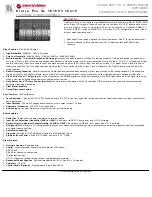
3-16
Cabling
Workbench-Mounted Switch
For an integrated chassis, you do not have to care about the cabling inside or outside the cabinet. All
the interface service cables of the S7900E series except the S7906E-V run on the left side of the
chassis, but the interface service cables of the S7906E-V run on the upward or downward cabling racks.
The power cables (including AC and DC power cables) of the S7900E series except the S7902E and
S7903E-S run out of the front of the chassis, but those of the S7902E and S7903E-S run out of the rear
of the chassis.
Rack-Mounted Switch
For the switches mounted in a 19” standard cabinet or N68 cabinet, the service cables are bound on the
cable binding rack at the left side of the chassis and arranged to run on the cabling rack or in the raised
floor according to the situation in an exchange equipment room (whether the signal cable of the room is
accessed from the cabling rack on the top of the chassis or the cabling rack under the floor.) Collect all
the transit data signal cable connectors and locate them on the floor of the chassis (instead of any
places outside the chassis for fear of unexpected damage). The power cables run out of the front right
side of the chassis and either on the cabling rack or in the raised floor as near as possible according to
the situation in an exchange equipment room (concerning DC power distribution cabinet, lightning
protection box, terminal strip and so on).
General Cabling Requirements
Minimum curvature radius of cables
z
The curvature radius of a fixed power cable, communication cable, or ribbon cable should be at
least five times the cable’s outer diameter. If the cable is frequently bent, plugged and unplugged,
the curvature radius should be at least seven times the cable’s outer diameter.
z
The curvature radius of an ordinary fixed coaxial cable should be at least seven times of the cable’s
outer diameter. If the coaxial cable is frequently bent, plugged and unplugged, the curvature radius
should be at least ten times the cable’s outer diameter.
Minimum curvature radius of fibers
z
When the fiber is wrapped up around the cabling plate, the diameter of the cabling plate should be
at least 25 times the fiber’s diameter.
z
When the fiber is being moved, the diameter of the cabling plate should be at least 20 times the
fiber’s diameter.
z
When the fiber is fixed, the diameter of the cabling plate should be at least 10 times the fiber’s
diameter.
The fiber’s diameter refers to the outer diameter of the fiber jacket. Generally, the diameter of a
single-core fiber is 0.9 mm, 2.0 mm, or 3.0 mm (0.04 in., 0.08 in., or 0.12 in.).
















































